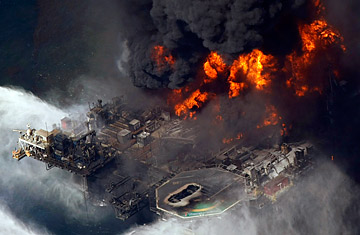
The Deepwater Horizon oil rig is seen burning more than 50 miles southeast of Venice on Louisiana's tip in the Gulf of Mexico.
The explosion on the Deepwater Horizon oil rig last week in the Gulf of Mexico was without question a human tragedy. The day after the rig finally sank on April 22, the Coast Guard called off the search for the 11 workers lost during the accident.
Now the accident threatens to become an environmental tragedy as well. Despite early hopes that the oil spill could be minimized, the rig's fractured drilling pipe is currently leaking 42,000 gal. of crude a day. The result is an oil slick on the surface of the water, covering more than 1,800 sq. miles, now just 20 miles from the delicate Gulf coastline. Depending on wind conditions, oil could begin washing up on the shore as early as this weekend. "If it keeps going — and that's a big if — the probability gets higher and higher that you could have a major impact on the land," says Nancy Kinner, co-director of the Coastal Response Research Center at the University of New Hampshire.
The Coast Guard and the energy giant BP, which operated the sunken rig and is responsible for the cleanup, have launched a massive operation to contain the spill — an unusual challenge, considering the complexity of underwater drilling. First, remote-controlled robot submarines have been deployed to try to seal off the oil well altogether by activating a massive device called a blowout preventer. If the 450-ton valve at the wellhead can be turned on, the oil flow should stop, and the spill could be ended quickly. But the outcome is far from guaranteed; robots have never been used in an operation of this magnitude nor at this depth — some 5,000 ft. below the surface of the ocean.
Even as the robots do their work (officials should know within a day whether the robots were successful), BP is preparing to drill a relief well into which the original well would empty. That could allow the company to inject a heavy fluid into the broken well that would slow and eventually stop the flow of oil. Once the leak is stanched, BP could permanently seal the first well.
But the entire operation would likely take months, during which time the oil would keep spilling. So BP is also preparing to build a massive dome that could be placed over the oil leaks — which are emanating from a pipe that connects the well to the sunken rig — and actually collect the leaking crude. The only problem is that such an enterprise has never been attempted in deep water, and it would take at least two weeks to be put in place. "I want to be careful with expectations," said Doug Suttles, the chief operating officer for exploration and production at BP, in a news conference on Monday, April 26. "It's a very challenging work environment."
Already more than 1,000 people are working on the cleanup, along with more than 32 ships and several aircraft. The vessels are dragging long booms to corral the oil on the surface — which is still a thin slick, not yet a thick tar — while the planes spray chemical dispersants that can separate the crude from the water, in hopes that it will evaporate. "Our response plan is focused on quickly securing the source of the subsurface oil emanating from the well, cleaning the oil on the surface of the water and keeping the response well offshore," said Coast Guard Rear Admiral Mary Landry, the federal on-scene coordinator for the spill response.
Coast Guard officials said they would consider a controlled burn of the oil, possibly as soon as Wednesday. Pools of oil would be trapped in containment booms and set on fire — a technique that could effectively burn 50% to 95% of the collected oil. The burning oil would also create a plume of smoke and air pollution, which could affect flying birds. But according to the National Oceanic and Atmospheric Administration, marine wildlife would be less harmed by a burning area of the ocean than by exposure to an oil slick.
At the current rate, oil would have to leak from the Deepwater Horizon rig for more than 260 days to compare in magnitude to the Exxon Valdez accident, which spilled 11 million gal. of oil into Alaska's Prince William Sound in 1989. Actual environmental harm in the Gulf of Mexico, which is accustomed to the oil and gas industries onshore and off (about one-third of U.S. petroleum production now comes from the Gulf), would not be as severe as that in the relatively pristine Alaskan waters. But the Gulf's $2.4 billion fishing industry could be imperiled by a major spill, as could tourism up and down the Gulf Coast and potentially the Florida panhandle. "We are being very, very aggressive," said Tony Hayward, the CEO of BP, which expects to spend some $100 million on the cleanup. "This is the biggest response by anyone in the industry ever, and we're able to do it because we planned for it. We will be judged by our response."
They will be, but those who doubted the wisdom of expanding offshore exploration for oil and natural gas may have already made up their minds. In Florida, Republican lawmakers have been pushing to open drilling as close as 10 miles offshore, but in light of the Deepwater Horizon accident, which occurred less than 100 miles from the beaches of Pensacola, Governor Charlie Crist is having second thoughts. "I'm not sure this was far enough," he said on Monday. "I'm pretty sure it wasn't clean enough, and doesn't sound like it was safe enough. If this doesn't give somebody pause, there's something wrong."
